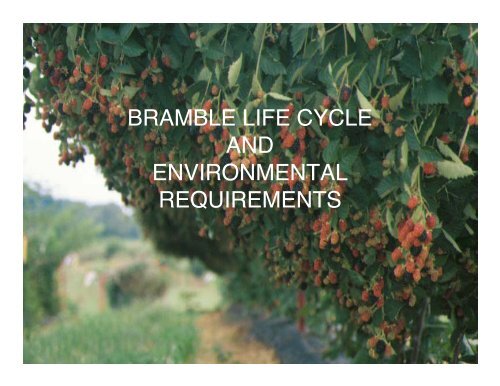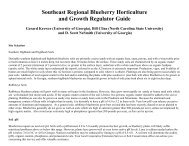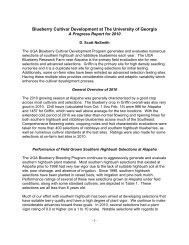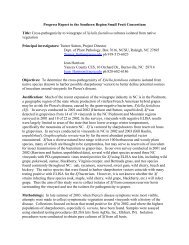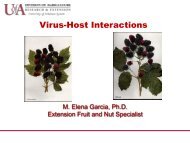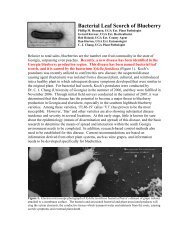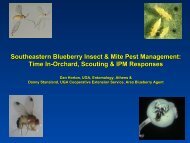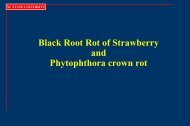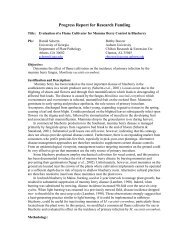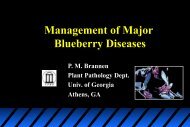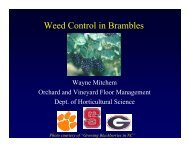bramble life cycle and environmental requirements - The Southern ...
bramble life cycle and environmental requirements - The Southern ...
bramble life cycle and environmental requirements - The Southern ...
You also want an ePaper? Increase the reach of your titles
YUMPU automatically turns print PDFs into web optimized ePapers that Google loves.
BRAMBLE LIFE CYCLEANDENVIRONMENTALREQUIREMENTS
Rubus TaxonomyFamily:Rosaceae(Batology)Subgenus Ideobatus - raspberry (200 species) Rubus ideaus -red R. occidentalis -black R. neglectus- purpleSubgenus Eubatus - blackberry (>>> 200 species) R. allegheniensis R. argutus R. cuneifolius R. canadensis R. frondosus R. ursinus (most often cited, but not always actualparent)
DewberriesDewberries are basically smaller, prostrate,low-chill blackberriesNative to the southeastern US.Can be any species or cultivar of trailingblackberryR. baileyanus (eastern US)R. ursinus (western US)etcCenter flowers in cluster open first vs outer inerect types (now murky)
Plant MorphologyGrowth HabitPerennial rootsBiennial shoots: primocane (first year) floricane (second year)
PhenologyPlant Life CycleFirst yearCanes grow but do not produce fruit*Called primocanesSecond yearCanes produced last year bear fruit <strong>and</strong> dieCalled floricanes (fruiting canes)* Primocane fruiting <strong>bramble</strong>s are the exception
Plant growth - plant partsCrownFruitPerennial roots
Animation of <strong>bramble</strong> <strong>life</strong> <strong>cycle</strong>
Primocane FruitingRaspberries <strong>and</strong> BlackberriesFirst year Canes grow <strong>and</strong> produce fruit on tips ofcane in late summer to fall of first year Usually pruned in winter to groundSecond year If canes are not pruned in winter, fruitingwill commence in spring from mid sectiondown 10% of total yield
Animation of primocane fruiting
<strong>The</strong> Raspberry Plantred raspberry black raspberry
<strong>The</strong> Blackberry Planttrailing thornlessupright thorny
Climatic <strong>requirements</strong>Raspberries Cool temperate summers, sustainedwinter temperatures, winter injury -20°FBlackberries Warm temperate summers, toleratesfluctuating winter temperatures, winterinjury at 0ºF
Flower initiationShort day, lowering tempsFlower buds initiated in terminal budChanges from a vegetative bud to areproductive budContinues down caneRaspberry fall <strong>and</strong> springBlackberry fall ,winter <strong>and</strong> spring?
Inflorescence developmentDevelopment controlled by tempsLow temps stop developmentRapid differentiation <strong>and</strong> development inspringBudbreakShort, lateral, leafy branches terminate in aninflorescenceNumber of flowers vary w/cvs
Primocane fruitingInitiate flower buds in summerinternodes below tip continue toelongate for short period of time but nonew lateral budsLateral buds on upper portion of canegrow <strong>and</strong> produce lateral branches withlateral flower buds
Flowering to fruitOuachitaApacheArapahoNavaho50%bloom7 May5 May4 May7 MayPeakFruiting19 June30 June11 June1 JulyNo. days42563855
Dormancy
Winter temperaturesChilling requirement (hrs
Chilling Units (hrs 35-45F)
Dormancy - State of RestShorter days <strong>and</strong> cool tempsCanes stop growingAcquire hardinessMaximum hardiness 1-2 months later(Jan)Cannot resume growth even if tempsare warmerBlackberries??
Winter injuryEarly fall frosts Can growth slows/stops Plant slowly becomes more cold hardy Early onset of below normal temps. cancause damage Earlier <strong>and</strong> lower temps cause more severedamage Dieback <strong>and</strong> death of canes Late maturing cvs <strong>and</strong> plantings with poormanagement practices, subject to this typeof injury
Winter injuryInjury during dormancyMost hardy periodGenetic hardiness primary factor, environmentclose secondType of <strong>bramble</strong>Red raspberryPurple raspberryBlack raspberryBlackberryLow temp limit(ºF)-20-10-50
Winter injuryLate season freezes Cane gradually decrease in hardiness Even a few days above 28F in low chilling types Cvs resistant to low midwinter temps cansuffer late season freeze Symptoms include: Dieback of canes Failure of laterals to develop Weak lateral growth Normal initial growth followed by collapse Interior of bud is black or conducting tissueis black (damaged)
Winter injuryFreeze during flowering 28ºF Raspberries <strong>and</strong> early fruiting blackberries Pistils most tender Flowers develop black centers 1-2 daysafter freeze Fruit does not develop or only fewdrupelets
Blossom freezes“Blackberry Winter” cold spell that occurs while blackberriesare in bloom return of polar air mass after warmer airmasses have begun to dominate.
Winter injury…in general…..Red>black <strong>and</strong> purple raspberriesErect>TrailingThorny>thornless
Raspberrywinter injury
Blackberry winter injury
Summer TemperaturesRaspberries 70°F optimumBlackberries ~80ºF optimumHeat, bright sun <strong>and</strong> low humidity Reduce fruit size <strong>and</strong> yield Sunscald fruit
Light Response
Temperature response
Summer tempsAve # days/yer above 86ºFBlackberries: zones 6-8Raspberries: zones 3-4(PNW or high elevation)
WindWinter Strong cold winds desiccate canesSummer Wind <strong>and</strong> h<strong>and</strong>ling can decrease yield
<strong>Southern</strong> adapted raspberries?


